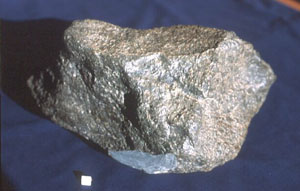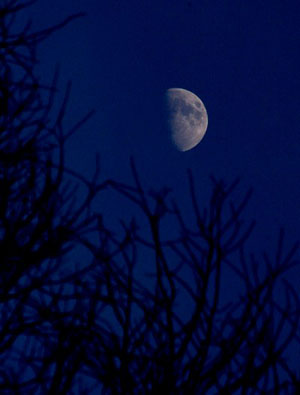Even though astronauts have set foot on the Moon, analysed its surface and brought samples back to Earth, we do not yet fully understand the Moon’s origins nor how it has evolved during the last few billion years since its formation. New clues have now emerged from a study of the Moon’s past volcanic activity that suggest that volcanic activity began 4.35 billion years ago (+/- 0.15billion), a relatively short time after the formation of our planet’s biggest satellite.
Kentaro Terada of Hiroshima University, in Japan, and Mahesh Anand of The Open University, Milton Keynes, UK, and their colleagues have dated minerals from a fragment of a lunar meteorite dubbed Kalahari 009, which overturn the notion that volcanic activity on the Moon began a mere 3.8-3.9 billion years ago. The fragment is classified as a very-low-titanium breccia a piece of crystallised magma from a lunar mare (sea) basalt. The team used ion microprobe uranium-lead dating of phosphates in this chunk of moon rock to reset the volcanic clock.

Information locked in Moon rocks could provide clues about the early solar system (Credit: Institut fur Planetologie, Universitaet Muenster)
The researchers suspected that the fragments of crystallized magma come from the earliest eruptions on the Moon’s vast plains. These ancient phosphate ages are thought to represent the crystallization ages of parental basalt magma, making Kalahari 009 one of the oldest known mare basalts, the researchers say. Lunar rock samples collected by Apollo astronauts resulted from more recent eruptions although these high-titanium collected samples are much older than other known low-titanium samples.
The authors suggest that the Moon’s volcanism must have started at the time its crust was forming and that the Kalahari 009 meteorite is the first example of a ‘cryptomare’ sample from the Moon as it conveys a hidden signature of the Moon’s earliest history.

Mahesh Anand
According to Anand, rocks from the Moon are the only source of samples that allow us to probe back to the first 500 million years of the solar system. Such ancient rocks have long since been subsumed by plate tectonics on Earth, the Moon rocks represent a geological fossil record.

The Moon
Further reading
Nature, 2007, 450, 849-852;
http://dx.doi.org/10.1038/nature06356
Mahesh Anand homepage
http://www.open.ac.uk/planetarygeology/
Suggested searches
Moon